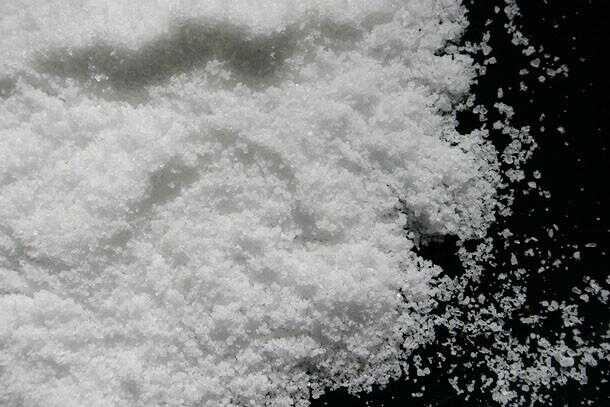
Sodium nitrate and sodium nitrite, also known as curing salts, are preservative food additives widely used in the food industry, they can be used together or alone. They have a very similar chemical composition. Precisely for this reason, many people get confused when deciding which of the two is best used when preparing preserves or meats that will require periods of curing, smoking, fermentation or extending their shelf life for later consumption. The difference in the chemical composition of these two additives is just one oxygen atom, sodium nitrite (NaNO2) has two oxygen atoms, while sodium nitrate (NaNO3) has one more oxygen atom.
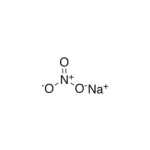 |
 |
Nitrates can transform into nitrites when losing oxygen and the opposite can also occur. They are widely used in the food industry because they prevent the growth of bacteria, help combat rancidity and change the color of the meat to a reddish tone, typical of cured products (ham, bacon, sausages, etc.), which occurs due to reaction of nitrite with myoglobin present in meat. The pink color is obtained due to the pigment nitrosylhemochrome, which is the heat-denatured form of nitrosomyoglobin, which, in turn, is formed through the reaction between nitric oxide (NO) from nitrite (NO2) and natural myoglobin from meat. Understanding the set of reactions that involve nitrite is essential for understanding the formation and color stability of cured products.
Preservatives are added to extend shelf life and prevent the growth of harmful microorganisms. In the specific case of processed meat foods, they have been used for more than five decades and nitrates and nitrites have been playing an important role in preserving, providing color, flavor and texture to such products. They are among the most effective preservatives as they have antimicrobial action, inhibiting anaerobic bacteria, such as, for example, Clostridium botulinum (botulism).
Should I use sodium nitrite or nitrate?
Previously, sodium nitrate (NaNO3), from mining in Chile, was the component used in the curing process, but after the discovery that, during curing, sodium nitrate is converted into sodium nitrite, and this is responsible for the benefits sought during the process, isolated sodium nitrite began to be used predominantly.
Therefore, essentially, the difference is the immediate action of sodium nitrite, as it does not require time for this conversion of one component to another during the curing process compared to the need for chemical conversion of sodium nitrate. As nitrate is converted into nitrite, the dosage is also easier to control using nitrite directly. Another point is that nitrite acts at low temperatures, between 2 and 4°C. Sodium nitrate is widely used in products that have a long cure, such as salami and Parma ham, for example, as it works slower and longer.
Read too curing salt what it is and how much to use
Is nitrite bad for your health?
Nitrates are naturally present in vegetables and can be found in these foods in very high concentrations. Spinach or celery, for example, can naturally contain more than 2g/kg of nitrate (ten times more than the maximum concentration authorized as an additive). Nitrates may also be present in other vegetables, such as beets and chard, or in drinking water.
In the human body, nitrite can form nitrosamines. This formation only occurs under certain conditions, including strongly acidic conditions, such as that inside our stomach.
Studies, carried out mainly in the USA, suggest that excessive consumption of processed meats may be related to an increased chance of developing cancer, diabetes and heart disease. But there is no unanimity in this understanding as other studies present divergent conclusions.
Ascorbic acid (vitamin C) or similar antioxidant compounds such as sodium erythorbate and vitamin E can be added to cured foods to reduce the formation of nitrosamines.
Read the post Nitrite conversion time in cured meats where studies are presented on the reduction/conversion of nitrite in products.
Nitrates and nitrites and the risk of cancer
There is a controversy that began in the 1970s that the ingestion of nitrates/nitrites is problematic for human health, mainly as potential causes of gastric cancer due to their reaction with secondary amines and the eventual formation of nitrosamines. In 1975 it was discovered by MIRVISH (1975) that ascorbic acid (and the various forms of vitamin C) effectively inhibits the formation of this undesirable compound. Later, in 1996, it was also confirmed that α-tocopherol (vitamin E) has the same positive effect. Therefore, these antioxidants are commonly used in modern cured meat processes and in various sausages, and are also covered by Brazilian legislation.
Studies
Despite the controversies, several epidemiological studies have failed to clearly prove the paradigm of the association between nitrate/nitrite intake and the risk of human cancer. Its conclusions are considered by many authors to be discrepant, inconsistent and limited, when carefully analyzed on scientific merit.
In 1980, a study was carried out on lymphatic cancer in rats in a multidisciplinary project involving the FDA and the USDA, this study was conducted by the Massachusetts Institute of Technology(MIT) and published by the FDA in 1980. The conclusion is that it is not possible to demonstrate the relationship between the incidence of this tumor and sodium nitrite intake.
In 1982, the US National Academy of Sciences required an assessment on this topic. The evaluation was carried out by the FDA and the results were published in 2000 without evidence of carciogenicity of nitrite. This study definitively sealed the approval of sodium nitrite as a safe food additive.
Why do we continue to use nitrite in food?
The answer is simple, after tests and experiments, modern science has not yet found a better solution to aid the process of food healing and elimination of harmful microorganisms.
Alternatives for preserving meat are citrus substances, such as vinegar (in the form of a pH controller), citric acids (such as ascorbic acid) and common salt (sodium), however, taking into account that, if the pH is not controlled, the loads of the proteins that make up the meat muscles are affected, degrading important properties of the meat, such as liquid retention.
Should we eat foods with sodium nitrite?
It is better to ingest sodium nitrite moderately than to run the risk of potentially fatal food poisoning, such as that caused by a toxin produced by the bacteria clostridium botulinum (botulism), present in the soil and in contaminated and poorly preserved food. There are regulations that control the amount that can be included in food, therefore, moderate consumption is considered safe by public health agencies.
Eliminating the intake of processed foods with nitrites and nitrates does not eliminate them from the body. While less than 3 mg/day is generally ingested through food, about 12 mg/day is transferred through saliva, and intestinal bacteria produce about 70 mg/day. Therefore, they are compounds that will always be present in our body. Diets rich in vegetables can contain much more of these compounds than a moderate consumption of processed foods.
-
 Curing salt 1R$ 8,00
Curing salt 1R$ 8,00 -
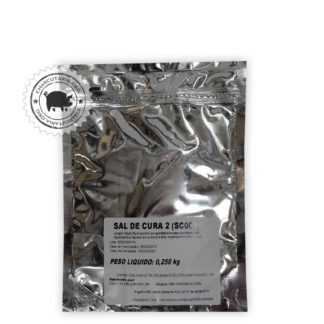 Curing salt 2R$ 8,00
Curing salt 2R$ 8,00 -
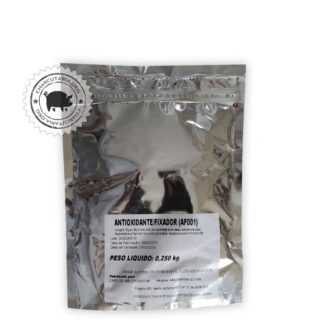 Fixative AntioxidantR$ 23,00
Fixative AntioxidantR$ 23,00 -
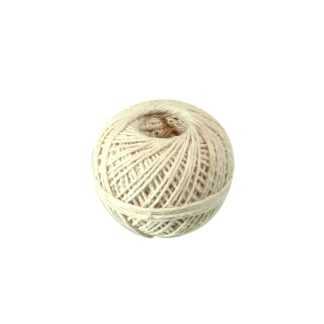 Culinary twineR$ 7,90
Culinary twineR$ 7,90 -
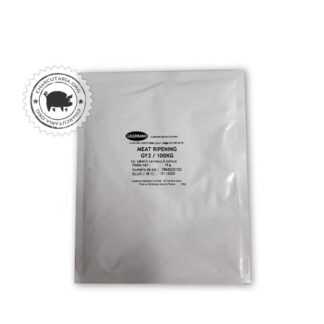 Starter CultureR$ 69,90
Starter CultureR$ 69,90 -
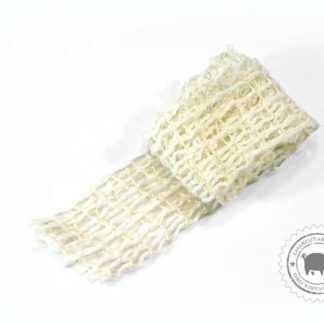 Culinary elastic net 50mmR$ 15,00
Culinary elastic net 50mmR$ 15,00 -
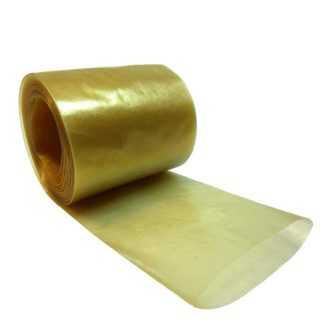 Collagen casing 45mm roll 5 meters salamiR$ 25,00
Collagen casing 45mm roll 5 meters salamiR$ 25,00 -
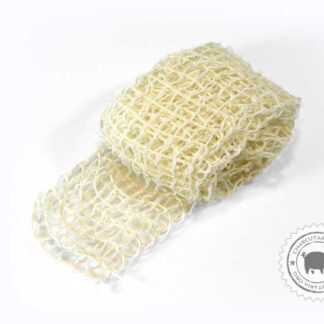 Culinary elastic net 65mmR$ 18,00
Culinary elastic net 65mmR$ 18,00 -
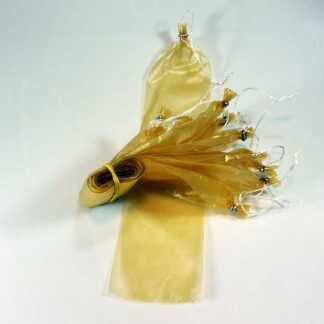 Salami collagen casing 45mm 10 units tiedR$ 22,00
Salami collagen casing 45mm 10 units tiedR$ 22,00 -
 Collagen casing 80mm cup and salamiR$ 29,90
Collagen casing 80mm cup and salamiR$ 29,90 -
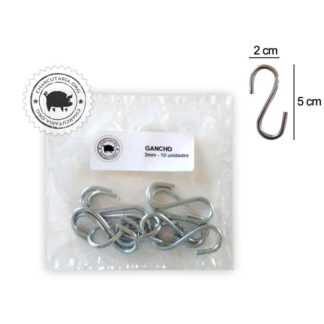 Galvanized HookR$ 12,00
Galvanized HookR$ 12,00 -
 Salami collagen casing 50mm 10 units tiedR$ 24,00
Salami collagen casing 50mm 10 units tiedR$ 24,00


For a mixed smoked sausage, which curing salt is best, how much should be used and how long should the dough rest before embedding?
Type 1 Curing Salt, 2.4g for every kg of meat. Let it rest for 24 hours.
How long should I wait for the curing salt#1 to take effect on a pork belly before I smoke it. Do you have a time x thickness table?
Ricardo, see the nitrite conversion times in this post. Regardless of the thickness and even after smoking or cooking, nitrite continues to be converted, so it is not necessary to wait before finishing the preparation, but rather wait before consuming. See in the post that after 2 or 3 days the nitrite will already be converted in large quantities. Nitrite conversion time in cured meats
Good morning. Isn't nitrite the curing salt 1? Isn't nitrate the curing salt 2?
Hi Souza. Curing salt 1 is the mixture of nitrite and common salt. Curing salt 2 is the mixture of nitrite, nitrate and common salt.
Good morning. I made a purchase, but I can't complete it, there are no options to pay with other credit cards. How to proceed. Grateful. Att.
If you have any problems, you can send us the list of products via WhatsApp and we can finalize the purchase there using your preferred payment method.
Good afternoon
After going through the curing time, with a loss of 40% of the original weight, I can place the pieces in vacuum plastic bags. like Pitina, Butifarra Dulce, copa loin and others?
Hi Edson, after losing weight you can put it in a vacuum and store it in the fridge.
Good morning!
I'm starting to produce sausages and I'm worried about using curing salt 1.
I purchased curing salt that contains the following ingredients:
Salt 93%
Sodium nitrite INS 7%
My question is, for every kg of meat 2.5g of curing salt?
And the amount of fine salt should I reduce?
Hi Zenóbio, use 2.5g for every 1 kg of meat. You can deduct this amount from common salt.
Good afternoon . I have a question regarding the shelf life of fresh pork/chicken sausage, after adequate use of sodium nitrite, which in some manufacturers of these sausages, inform that stored in the freezer at -18 C, it stays for 120 days, and in other manufacturers, combining sodium nitrate with sodium nitrite, and at the same temperature, the product's shelf life reaches 180 days. Can these numbers be trusted?
Hi Ruberval. Meat-packed sausages sold in supermarkets do have reliable expiration dates. They undergo laboratory analysis and generally reflect the deadlines presented. But there are several factors that can influence it in addition to the curing salt, such as acidity, bactericidal and antifungal ingredients such as garlic, onion and other natural condiments.
Goodnight,
About curing salt, whether to use it or not... I think that if I want to sell fresh artisanal sausage to order, and my purpose is to do it without preservatives and other additives, I can't use curing salt. However, I am very concerned about food safety. My question is: if it goes on the barbecue, frying or oven, will it kill all the agents that can cause harm to health, even in the case of botulinum toxin, right?! I read that 10 minutes above 80ºC would kill the bacteria. Is this information correct? Would it really be safe not to use the curing salt since it's going to be in the oven? I have a lot of doubts about this.
Hi Lu, I'm going to separate them by topics to make it easier. 1) “if I want to sell fresh handmade sausage to order”. According to legislation, fresh sausages must have curing salt. Unless you can obtain a seal of approval for a regional artisanal product in your municipality or state, but other than those exceptions, use is mandatory. 2) “10 minutes above 80ºC would kill the bacteria” Yes, but some bacteria generate toxins, as is the case with botulinum, so even if you eliminate the live bacteria from the product, the toxins that have already been released will still be there. The problem in this case is not the ingestion of the live pathogen, but rather the toxins it generated while it was active in the product. The curing salt inhibits the proliferation of these pathogens (consequently of toxins) while the product is still raw. 3) “Would it really be safe not to use the curing salt since it’s going to be in the oven?” Only if it goes into the oven/grill immediately after production as this way there is no time for the product to proliferate in its natural state. But even so, you need to make sure that everyone has been eliminated. 4) “I am very concerned about food safety” I recommend using the minimum limit. It is an approved additive… Read more "
It helped a lot. Our! Thank you very much for responding! So if the safest option is to always use curing salt, I will definitely use it. I'm very afraid of foodborne infections. This is the only mandatory additive, right? Is it 2.5 grams per kg of meat even though it is chicken/pork/beef? (Based on the #1 curing salt sold by you here, because that's what I'm going to buy) I read you explaining to people that overdoing the curing salt is bad, but what if by chance I use 4g per kg, will there be same effect or will it do harm? Is there a margin for error? hehe (if the minimum is 2.5g I'll use 2.5g! the question is based on a scale error) Just one more question, sorry for taking too much. Can I freeze the fresh sausage (with #1 curing salt) as soon as it is ready or does it have to be left in the fridge for a few hours? Before selling it, I'm going to do it at home and for my family for a while, only after it's really good do I plan to see if it generates any extra income. My family eats a lot of sausages and sausages and this bothers me because these products are of poor quality. Thank you SO MUCH again… Read more "
1) This is the only mandatory additive, right? Is it 2.5 grams per kg of meat even though it is chicken/pork/beef? You have to check the legislation for each product, but in general it is the only mandatory additive. 2) but what if by chance I use 4g per kg, will it have the same effect or will it be harmful? Is there a margin for error? 4g is within an acceptable range, what the legislation says is that the final product cannot have more than 150ppm of residual sodium nitrite in the final product. These 2.5g of curing salt added relate exactly to this maximum residual (150ppm), not counting the conversion that occurs between nitrite and the meat, so in theory you can add more than these 2.5g as there will be conversion/reduction . To know exactly how much you can put, just test and carry out laboratory analyzes on each product. Without analysis, I recommend that you use up to 3g per kg of meat, which is a very, very safe range. It is even dangerous to consume close to 1g of pure nitrite, which would be present in more than 40g of this standard #1 curing salt. So see that the safety margin is very high. 3) can I freeze fresh sausage… Read more "
Thank you very much!
Hello
I saw a recipe for making smoked bacon but I was wrong with the proportions. Instead of putting 0.25%, I put 2.5%.
The bacon is curing in the fridge, wrapped in plastic bags. What complications can this generate? What should I do?
I've seen in another post that the amount of nitrite decreases over time. If I leave it curing for longer, will it help?
Jonas, send the proportions of additives in the curing salt you used (how many % of sodium nitrite). And how many kilos of meat did he make? The best thing is to calculate how much pure additive entered the meat to know if there is any risk.
That's another problem. The packaging states that it contains sodium chloride, sodium nitrite and sodium nitrate. But the proportions are not described.
It is a curing salt from the Doremus Alimentos brand, on the packaging it is called Curing salt K001. I've already sent them an email, but they haven't responded.
I prepared 5kg of bacon and used about 100g of curing salt.
This is a difficulty in Brazil, as there is no standard, each manufacturer invents a formulation. Not informing the quantity is negligent as it is an additive that, if ingested in excess, poses a health risk. If this curing salt has 6% of sodium nitrite, then add 6g of nitrite to 5kg of meat. But this curing salt can have 10%, 15%... then it becomes quite risky as the ingestion of residual sodium nitrite in the meat cannot reach even close to 1g. That's why I've currently only purchased curing salts formulated in the instacure#1 and instacure#2 standards. In my opinion, if they don't answer what percentage of the product is, you should discard the meat.
I contacted them via email. Curing salt contains 6% sodium nitrite and 4% sodium nitrate. I've already discarded the meat and will be more careful next time. Thank you very much for the feedback, it helped me a lot.
Jonas, call the company with the batch number and product code (not K001) it is another code that is on the packaging, that way they were able to help you find out… 11.2436-3333
The company responded to my queries via email. They were very attentive. Thanks for the tip.
Good afternoon, I want to know how much sodium nitrite I need to put in the sausage, I will start making it. I want to sell it frozen
Hi Sandra, you will use pure sodium nitrite or a curing salt with sodium nitrite in the composition. If you are going to use curing salt, please indicate the amount of sodium nitrite that the curing salt you purchased contains. The composition is usually described on the package.
Good morning, Eduardo! How are you? I have a coppa in the process of being cured, when I went to buy the curing salt to use it I ended up buying the wrong product and consequently used the same one for the cure, do you think there will be any problems with this type of colpa that I used? See attached image. Thank you
Hello Tiago. The ideal for coppa is to use type 2 curing salt, with sodium nitrate and sodium nitrite. From what I've seen, this curing salt has 5% of sodium nitrite, so the recommended addition is 3g per kg of meat. If you follow this amount, I believe you will not have any problems. Monitor daily to see if any signs of contamination appear. Clean the piece by rubbing a cloth soaked in brine from time to time and, if you want, additionally give the pieces a bath in red wine to acidify them and ensure more protection. Hugs!
I used 2.5g per kg! I just have one more doubt regarding the other component in the curing salt, which would be Sodium Erythorbate (INS316). Thanks again for your patience and attention!
Sodium erythorbate is a curing aid, it works together with sodium nitrite, increasing the conversion rate of nitrite into nitric oxide, accelerating curing, fixing the reddish color more quickly and preventing rancidity, as it is an antioxidant.
With this I must reduce the healing time, which is expected to be 14 days.
Tiago, despite having used curing salt 1 with erythorbate, it is still better to calculate the time for weight loss. When you lose at least 30% of your initial weight you can stop. If you want a firmer cup, wait until you lose 40% of weight. Too little time will leave the cup very soft, with a raw meat flavor.
Hello Eduardo. I went in search of curing salt 1 to cure a pork belly for 7 days and then smoke it, but I only found a product containing the two salts together, 1 and 2. The packaging doesn't say what the concentration of the two salts is, just says that the amount of product to be used is 0.25% in relation to the weight of the meat. As this percentage matches the recommended use of curing salt 1, I decided to take a risk and apply it to the meat. Do you believe that a problem could happen? Thanks.
Junior, good morning. In Brazil, each manufacturer makes a concentration of additives, there is no rule, so both curing salt 1 and curing salt 2 can have varying amounts of use depending on the manufacturer. Ideally, the packaging would show or accompany the technical sheet, but if they specify the use of 0.25% then there probably won't be any problems. If there is a phone number or email, try asking the manufacturer for the information. If you cannot obtain the information and are concerned, as it is a smoked product that lasts well, leave the smoked belly in the refrigerator for another 7 days before consuming, this way the additives will decay from the final product and the residual concentration will be very low. . Hugs.
Thank you very much for your feedback Eduardo.
Big hug!
Hello goodnight. I researched a lot before making salami but I found a wrong recipe where there was too much curing salt in the recipe. About 5 or 6 times. After that I read many articles. Is consumption too dangerous? Well, I don't know what to do.
How much curing salt did you use and what percentage of sodium nitrite and/or sodium nitrate did you use?
I used 2# curing salt. With 6% and 4%. But there is a wrong recipe on the internet and about 20 grams of curing salt was used per kilo. I believe it is best to discard the correct product?
Maybe it was a typo in the recipe, let the writer know! Sodium nitrite is converted during curing and, in the minimum recommended quantity, it is completely converted in a matter of a few hours. Only sodium nitrate takes time as it is converted into nitrite during curing. The lethal dose of pure sodium nitrite varies between 0.7g and 6g, that is, ingesting the pure additive (without mixing with table salt) in amounts close to 1g can be fatal in some cases. If you added 20g of curing salt with 6% of sodium nitrite, then, if my calculations are correct, you added 1.2g of sodium nitrite, right? With the conversion I believe this has been drastically reduced, but when in doubt it is better not to eat it! “The lethal oral dose of nitrite for adults has been variously reported to be between 0.7 and 6 g NO2- (approximately 10 to 100 mg NO2-/kg) (WHO, l985; Corre & Breimer, 1979; Fassett, 1973; De Beer et al., 1975). Lower doses may apply for children (especially neonates), the elderly and people with certain enzyme deficiencies. The broad range is due to the wide variability in individual sensitivity illustrated by the following… Read more "
Good morning, I would like to purchase Nitrate at 2%. Do you know where to buy?
Antonio, 98% of salt and 2% of sodium nitrate? If the quantity is large, you may be able to order it from the manufacturer, but if there is little, the best option is to buy one with, for example, 4%, and use half the quantity you would use. This way you get the desired 2%.
sorbate and nitrite can cause some reaction in the meat, for example making the salami yellow on the outside
Potassium sorbate and sodium nitrite? Can you send a photo? How much are you adding additives?
I'm going to make Raw Ham (Jamon, Prosciutto Crudo, etc.) and I'll use Curing Salt #1, which is the easiest to find. Will I lose a lot in conservation efficiency, since this food is not for immediate consumption? I have made Raw Ham on other occasions using just salting and immersion in coarse salt.
Cyro, I don't think you'll miss much. The original Parma Ham, for example, can only be made with common salt and nothing else. So it is perfectly safe to protect with just common salt, temperature and gradual reduction of water.
What is the #1 Curing Salt and what is the #2 Curing Salt? I am going to start making cups and pancetta for personal consumption, curing and maturation in the refrigerator. Which would be the most suitable?
Hi Paula, curing salt 1 or instacure#1 (North American nomenclature) contains table salt and sodium nitrite and is used for quick curing in products for immediate consumption, smoked or cooked immediately after production, such as sausages, bacon, cooked hams and fresh sausages. Curing salt 2 or instacure #2, which contains table salt, sodium nitrite and sodium nitrate, is used for products that will undergo a long curing process, such as salami, copa and raw ham. How long will coppa and pancetta cure? Recipes vary a lot but the decision of which one to use is always associated with the curing time.
Hello, I have a doubt.
To smoke, should I use Curing Salt 1 which only contains Sodium Nitrite (INS 250) or should I use Curing Salt 2 which contains Nitrite and Sodium Nitrate? Thanks in advance.
Felipe, if your product is to be finished in the smoker, then you can only use sodium nitrite. If you are going to smoke and then cure the product, then it is recommended to also use sodium nitrate.
Hello good afternoon,
Buy an Ibrac Curing Salt that contains Salt (90%), Consevante INS 250 (6%) and Preservative INS 251 (4%). I would like to know what INS 250 and INS 251 preservatives are. Are they nitrite and nitrate? Can I use this curing salt to make long-aged sausages, sirloin steaks and Parma ham?
Thank you very much in advance
Bruno, yes these additives are sodium nitrite(INS 250) and sodium nitrate(INS 251), you can check this list of additives food. You can make long-lasting sausages with this additive, as sodium nitrate is long-acting and is used exactly for this type of product. If it were for quick consumption, you could just use sodium nitrite.
Can potassium sorbate be used to replace nitrites and nitrates? Would this bring any benefit?
Potassium sorbate will help with conservation as it is antifungal and bactericidal, but it will not bring any action in the curing process similar to sodium nitrite, such as color and flavor. If the objective is just conservation, then yes, you can replace it. The benefit is that it would prevent the formation of nitrosamines, which is the downside of sodium nitrite.
Carlos Humberto. Eduardo, do you know of a natural preservative based on jaboticaba, I think a college is developing it
Carlos, I don't know! I know of a natural antioxidant, which is rosemary extract. It is already sold commercially.
I would like to know if I can use sodium nitrate in pastry dough, in order to improve its durability, and what the harms and benefits are.
No, sodium nitrate is a preservative for meat. Search for Potassium Sorbate which I believe is more suitable for pastry dough.
Good evening, in long curing, where you use both salt with nitrite and nitrate, the proportion of both cannot exceed 2.6 grams/kg? Should I put 50% of each mixture? Thanks
Fernando, ANVISA regulates double the amount for nitrate, that is, 0.3g per kg of meat. Curing salts that contain both additives usually come with different proportions of nitrite and nitrate. Just look at the recommended use on the label. see the Anvisa ordinance on food additives and their limits of use.
Good morning. I got it from a friend who knows about my passion for charcuterie, nitrite and pure sodium nitrate. I wanted to know if I should mix it with table salt, in order to dilute the products, and what would be the proportion? I'm afraid of using salts in such a pure state, and it could end up being harmful to my health. Congratulations on the posts. extremely good taste and very eucidative.
Mix with table salt! Most curing salts are composed of 93.75% of table salt (sodium chloride) and 6.25% of sodium nitrite (NaNO²). Some also contain 4% sodium nitrate (NaNO³). Only around 3g of this mixture is used for each kg of meat, that is, close to 0.2g of nitrite per kg of meat. Depending on how much he gave you of this pure, it will yield many, many kilos of curing salt! Read the official documentation in the post docs Curing salt
Goodnight! This site is very good, but like everyone else I also have doubts, when making jerkd beef, with an injection of 50% how many ppm should I have in a brine, to have a good preservative effect without exceeding the permitted limits, and have a long-lasting product useful on the shelf.
Sodium nitrite has also been used in medicine and veterinary medicine as a vasodilator, reducing blood flow, as a bronchodilator, an intestinal relaxant or a laxative, and an antidote for cyanide poisoning.
Recent studies have found a link between high consumption of processed meat and colon cancer, possibly due to preservatives such as sodium nitrite.
Is there any way to cancel this reaction that causes the meat to change color??
This doubt is now cruel! Hehehe
Is there any curing salt or cure that does not give the meat a red color? Both nitrate and nitrite have the side effect of reacting myoglobin with the appearance of the red color typical of sausages.
However, there are sausages with a long shelf life in German delicatessens, such as the German white sausage which does not have a white color and has a good shelf life, as well as several white sausages such as blaquet which are white or brownish with no sign of nitrosylmyoglobin.
How is shelf life increased, avoiding botulism without using nitrates, or avoiding reddish color in the meat?
They must use preservatives that do not react with the meat. There is a list of preservatives released by Anvisa in a post here. Botulinum toxin is not generated at pH below 4.3. Then you should use citric acid or another acidifier.
I'm curious, the refrigerators that produce
Dry meat, what type of curing salt do they use?
All additives must be included on the product packaging (INS code or name). But as it is extremely salty, you may not need curing salt, just if it's for the red hue.